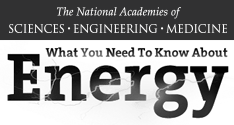
What You Need To Know About Energy
What do you know about energy?
What type of transportation uses the most total energy?
-
Correct!
By far the largest share of energy in transportation is consumed by cars, light trucks, and motorcycles—about 58% in 2012, followed by other trucks (21%), aircraft (9%), boats and ships (3%), and trains and buses (3%). Pipelines account for 3% and military uses for 2%.
-
Sorry, that’s incorrect.
By far the largest share of energy in transportation is consumed by cars, light trucks, and motorcycles—about 58% in 2012, followed by other trucks (21%), aircraft (9%), boats and ships (3%), and trains and buses (3%). Pipelines account for 3% and military uses for 2%.
-
Sorry, that’s incorrect.
By far the largest share of energy in transportation is consumed by cars, light trucks, and motorcycles—about 58% in 2012, followed by other trucks (21%), aircraft (9%), boats and ships (3%), and trains and buses (3%). Pipelines account for 3% and military uses for 2%.
-
Sorry, that’s incorrect.
By far the largest share of energy in transportation is consumed by cars, light trucks, and motorcycles—about 58% in 2012, followed by other trucks (21%), aircraft (9%), boats and ships (3%), and trains and buses (3%). Pipelines account for 3% and military uses for 2%.
-
Sorry, that’s incorrect.
By far the largest share of energy in transportation is consumed by cars, light trucks, and motorcycles—about 58% in 2012, followed by other trucks (21%), aircraft (9%), boats and ships (3%), and trains and buses (3%). Pipelines account for 3% and military uses for 2%.
What is the commonly accepted unit of measurement for electric current—or the amount of an electric charge passing a point per unit time?
-
Sorry, that’s incorrect.
The ampere, or amp, is the most commonly used measurement for electric current.
-
Sorry, that’s incorrect.
The ampere, or amp, is the most commonly used measurement for electric current.
-
Correct!
The ampere, or amp, is the most commonly used measurement for electric current.
-
Sorry, that’s incorrect.
The ampere, or amp, is the most commonly used measurement for electric current.
Which source(s) of energy are not nuclear in origin?
-
Sorry, that’s incorrect.
Tidal energy is gravitational in origin. Solar energy comes from nuclear reactions in the sun.
-
Sorry, that’s incorrect.
Tidal energy is gravitational in origin. Geothermal energy comes from radioactive decay inside the earth.
-
Correct!
Tidal energy is gravitational in origin. Solar energy comes from nuclear reactions in the sun, and geothermal energy comes from radioactive decay inside the earth.
-
Sorry, that’s incorrect.
Tidal energy is gravitational in origin. Solar energy comes from nuclear reactions in the sun, and geothermal energy comes from radioactive decay inside the earth.
Renewable energy (solar, wind, geothermal, hydroelectric, biofuels, waste, and wood) accounted for what percentage of the total energy supply in the United States in 2014?
-
Correct!
In 2014, 10% of our total energy use came from renewable energy sources, such as biomass, wind, solar, and hydropower.
-
Sorry, that’s incorrect.
In 2014, 10% of our total energy use came from renewable energy sources, such as biomass, wind, solar, and hydropower.
-
Sorry, that’s incorrect.
In 2014, 10% of our total energy use came from renewable energy sources, such as biomass, wind, solar, and hydropower.
-
Sorry, that’s incorrect.
In 2014, 10% of our total energy use came from renewable energy sources, such as biomass, wind, solar, and hydropower.
Since the beginning of the industrial revolution, about how much have atmospheric carbon dioxide concentrations increased?
-
Correct!
CO2 concentration in the atmosphere has risen about 43% since the beginning of the industrial revolution in the mid-eighteenth century-half of that since 1980
-
Sorry, that’s incorrect.
CO2 concentration in the atmosphere has risen about 43% since the beginning of the industrial revolution in the mid-eighteenth century-half of that since 1980
-
Sorry, that’s incorrect.
CO2 concentration in the atmosphere has risen about 43% since the beginning of the industrial revolution in the mid-eighteenth century-half of that since 1980
-
Sorry, that’s incorrect.
CO2 concentration in the atmosphere has risen about 43% since the beginning of the industrial revolution in the mid-eighteenth century-half of that since 1980
True or False: Burning biofuels does not release carbon dioxide.
-
Sorry, that’s incorrect.
Biofuels contain carbon and although they may burn “cleaner” than oil-derived fuels, they do not avoid generating carbon dioxide emissions.
-
Correct!
Biofuels contain carbon and although they may burn “cleaner” than oil-derived fuels, they do not avoid generating carbon dioxide emissions.
On average, how much solar radiation reaches each square meter of earth?
-
Sorry, that’s incorrect.
On average, even after passing through hundreds of kilometers of air on a clear day, solar radiation reaches Earth with enough energy in a single square meter to run a mid-size desktop computer-if all the sunlight could be captured and converted to electricity.
-
Correct!
On average, even after passing through hundreds of kilometers of air on a clear day, solar radiation reaches Earth with enough energy in a single square meter to run a mid-size desktop computer-if all the sunlight could be captured and converted to electricity.
-
Sorry, that’s incorrect.
On average, even after passing through hundreds of kilometers of air on a clear day, solar radiation reaches Earth with enough energy in a single square meter to run a mid-size desktop computer-if all the sunlight could be captured and converted to electricity.
Which of the following sources do experts expect will provide us with the “silver bullet” solution to our energy needs?
-
Sorry, that’s incorrect.
There is no silver bullet. Tomorrow’s energy, like today’s, will come from a variety of sources.
-
Sorry, that’s incorrect.
There is no silver bullet. Tomorrow’s energy, like today’s, will come from a variety of sources.
-
Sorry, that’s incorrect.
There is no silver bullet. Tomorrow’s energy, like today’s, will come from a variety of sources.
-
Correct!
There is no silver bullet. Tomorrow’s energy, like today’s, will come from a variety of sources.
Which renewable energy source contributed the most to the total energy consumed in the United States in 2014?
-
Sorry, that’s incorrect.
Wood and waste biomass, along with biofuels, accounted for about 50% of the U.S. renewable energy supply in 2014, and more than 4% of all energy consumed.
-
Sorry, that’s incorrect.
Wood and waste biomass, along with biofuels, accounted for about 50% of the U.S. renewable energy supply in 2014, and more than 4% of all energy consumed.
-
Correct!
Wood and waste biomass, along with biofuels, accounted for about 50% of the U.S. renewable energy supply in 2014, and more than 4% of all energy consumed.
-
Sorry, that’s incorrect.
Wood and waste biomass, along with biofuels, accounted for about 50% of the U.S. renewable energy supply in 2014, and more than 4% of all energy consumed.
Thank you for taking our quiz.
Place this badge on your facebook page to show your friends what you know about energy.
Place this badge on your facebook page to show your friends what you know about energy.
Place this badge on your facebook page to show your friends what you know about energy.
Explore Other Topics
Energy Hands-on
Understanding Efficiency
Learn the significance of energy efficiencyThe Promise of Better Lighting
Energy savings through lighting technologyOur Energy System
A visualization of all our energy sourcesEnergy Defined
- Greenhouse Gas
A gas which, like a greenhouse window, allows sunlight to enter and then prevents heat from escaping—in this case, from Earth’s atmosphere. The most common greenhouse gases are water vapor, carbon dioxide (CO2), methane (CH4), nitrous oxide (N2O), halocarbons, and ozone (O3).




